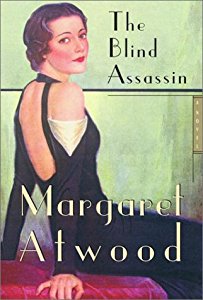
The Feminist Lens: A Pentadic Analsis of The Blind Assassin
I loved The Blind Assassin. I saw that Radical Readers and Feminisms For Dummies was reading it this month, and I thought to myself: That title sounds really familiar… I went to look at the bookshelves in my closet and, lo and behold, there it was among my mom’s books! Just waiting to be read! So I grabbed it and started immediately, and I couldn’t put it down. This book is truly epic, and the way Margaret Atwood weaves multiple stories together, revealing just enough information at a time to keep the pages turning, is absolutely masterful.
I could gush about the book for hours, and probably not even make a dent in the brilliance of this novel, I’ve decided to add to the discussion of the book by doing a Pentadic analysis of the marriage and subsequent love and sexual violence which ensued between the main characters.
(WARNING! There are spoilers in this post, so don’t read it if you haven’t finished! I’ve put the rest of this post after the jump to avoid angry readers!)
A Pentadic analysis is actually a form of rhetorical analysis with its roots in the theory of Kenneth Burke. As such, it is usually reserved for a rhetorical situation, not a fictional one, but I want to try it out here to hopefully reveal the importance some of the major elements in this book. Basically, in a Pentadic analysis, one looks at an act (what is done), agent (who is doing it), agency (what means the agent used), scene (the background or situation in which the act occurred), and the purpose (the reason why this happened). Once these terms are defined, one puts the terms into ratios and decides which term is more important in that ratio. These ratios are then used to define the motivation behind the act. So, let’s give it a try, shall we?
Definition of Terms: (For the purposes of this analysis, I’m going to define these terms very broadly, as this is meant to be an analysis of the entire book. However, this could just as easily have been done with one very specific situation in the novel, or a specific relationship1 in the novel.)
Act: Relationships in every sense of the word – Richard and Iris’s marriage, Richard and Winifred’s sibling relationship, Iris and Laura’s sisterhood, Richard’s violence towards Laura, Laura’s love for Alex, Iris’s affair with Alex
Agent: Iris, Laura, Richard, Alex, Winifred
Agency: Laura’s silence toward Richard, Iris’s writing of The Blind Assassin, Richard’s manipulation of Iris and Laura, Winifred’s manipulation of Iris and Richard, Alex’s stories
Scene: Canada, 1930’s-present (However, I’d argue that, in the sense of these relationships, the time period between 1930-1940 was probably the most important.)
Purpose: Iris married Richard to please her father; Richard abused Iris and Laura as a power play, or maybe just because he could; Winifred manipulated Richard and Iris to maintain her wealth and power; Iris fell in love with Alex that day in the attic and later had an affair with him because of that love, and because Richard treated her so poorly; Laura fell in love (or did she?) with Alex well before that, seemingly because she was so young and naive and he was so infatuating.
That was a super cursory analysis, but I’m trying to define terms in 600 pages of novel! Ah!
OK, so next comes the ratios of the terms. They’re set up like this: “Scene:Act” and the question being asked here is “Is the term on the left more important than the term on the right?” Then, a “Yes” or “No” will follow each ration, answering that question. Here we go!
Scene:Act Yes
Scene:Agent Yes – I’m arguing here that no matter who these people were, in this time and situation, this could have happened (You could argue differently; that’s where this type of analysis becomes incredibly subjective.)
Scene: Agency No
Scene: Purpose No
Act:Agent Yes
Act:Scene No
Act:Purpose No
Act:Agency No
Agent:Act No
Agent:Scene No
Agent:Purpose No
Agent:Agency No
Agency:Act Yes
Agency:Agent Yes
Agency:Scene Yes
Agency:Purpose No
Purpose:Act Yes
Purpose:Agent Yes
Purpose:Agency Yes
Purpose:Scene Yes
From this ratio analysis, you can see that I thought the purpose behind the actions was the most important part of this novel (it had the highest number of “Yes” answers), followed by the agency, and then the scene.
Based on this analysis, then, I argue that the scene, specifically the time period, coupled with the purposes and means behind the characters’ actions show that no matter who these characters were and what their personalities were like, in this time period and the culture created by a severe class divide in the middle of a severe economic depression, tensions run high, especially when the rich are trying to stay rich. This extreme class divide seems to breed a culture of hatred between the upper class and the lower class, and opens up possibilities for violence and manipulation of all kinds. I think that says a lot about world history and the treatment of women, doesn’t it?
Of course, as I said before, this is totally subjective, so feel free to argue with me! I’d love to hear your thoughts on this book, and this analysis!
This post is cross-posted at Radical Readers & Feminisms For Dummies.
- I define the word “relationship” in this novel simply as how one person relates to another. You absolutely could not define, for example, Richard’s violence towards Laura as a relationship in the sense that it involved anything mutual. However, I term it as a relationship here because the way they relate to each other is important.

